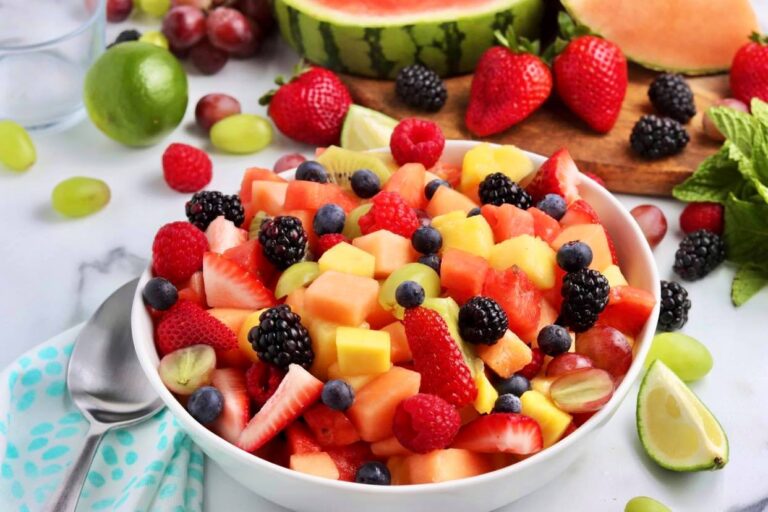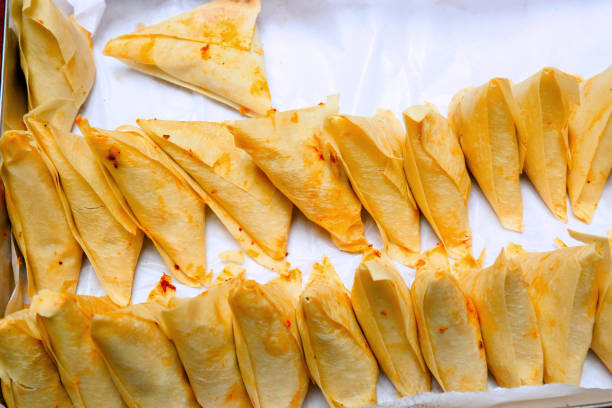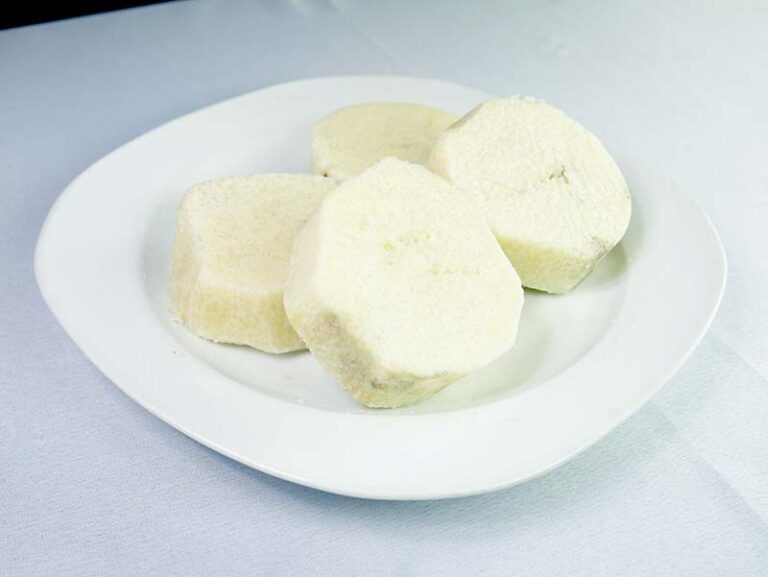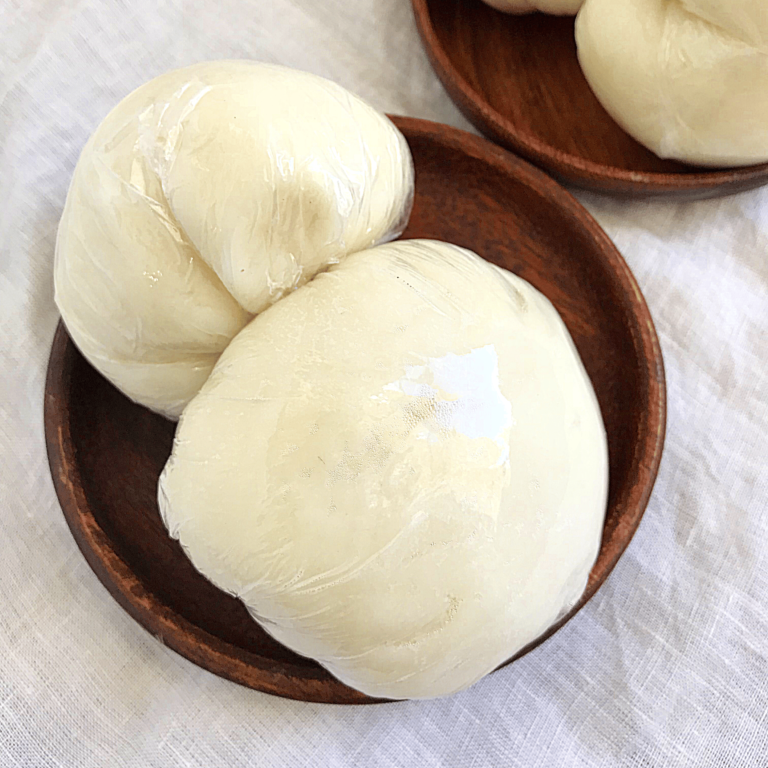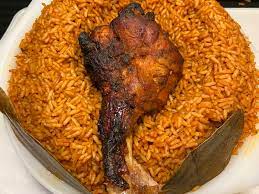Easy and Delicious Plantain Fufu Recipe
We’ll guide you through a step-by-step plantain fufu recipe that is both easy to follow and guaranteed to satisfy your taste buds. Plantain fufu is a delightful dish that brings together the rich flavors of plantains and the comfort of a classic fufu recipe. This versatile and gluten-free alternative to traditional fufu is gaining popularity worldwide due to its unique taste and simplicity.
Ingredients for Plantain Fufu Recipe:
To create a delectable plantain fufu, you’ll need the following ingredients:
- 4 ripe plantains
- Water
- Salt (to taste)
Instructions for Plantain Fufu Recipe:
Peel and Slice the Plantains
Begin by peeling the plantains and slicing them into small, evenly-sized pieces. This will ensure that they cook evenly and blend smoothly later on.
Boil the Plantains
Place the sliced plantains in a pot and add enough water to cover them. Add a pinch of salt to enhance the flavors. Bring the water to a boil over medium heat and let the plantains cook until they become soft and tender. This process usually takes around 10-15 minutes.
Drain and Mash the Plantains
Once the plantains are soft, remove them from the heat and carefully drain the water. Transfer the cooked plantains to a bowl and use a potato masher or fork to mash them until you achieve a smooth consistency. If necessary, you can add a small amount of the cooking water to adjust the thickness of the fufu to your liking.
Shape the Fufu
Traditionally, fufu is shaped into round balls or oval shapes using wet hands. To do this, wet your hands with water or oil to prevent sticking. Take a portion of the mashed plantains and shape it into a ball or any desired form. Repeat this step until all the fufu is shaped.
Serve and Enjoy!
Your homemade plantain fufu is now ready to be enjoyed. Pair it with your favorite African soups, stews, or sauces, such as egusi soup or groundnut soup, for a complete and satisfying meal. The fufu acts as a delicious base that complements the flavors of these traditional dishes.
Tips and Variations:
- For a sweeter twist, you can use slightly riper plantains.
- Experiment with different spices and seasonings, such as garlic powder or onion powder, to add extra flavor to your fufu.
- If you prefer a lighter fufu consistency, you can mix the mashed plantains with boiled yam or cassava.
- Leftover fufu can be stored in an airtight container in the refrigerator for up to 2-3 days.
Plantain fufu nutrition
Plantain fufu is not only a delicious dish but also offers several nutritional benefits. Here’s an overview of the nutrition provided by plantain fufu:
- Carbohydrates: Plantain fufu is a significant source of carbohydrates. It provides a good amount of energy, making it a suitable option for individuals with active lifestyles or those seeking a quick energy boost.
- Dietary Fiber: Plantain fufu contains dietary fiber, which plays a crucial role in maintaining a healthy digestive system. Fiber helps promote regular bowel movements, prevents constipation, and aids in overall gut health.
- Vitamins and Minerals: Plantains used in fufu preparation are rich in various essential vitamins and minerals. They are particularly high in vitamin C, which supports immune function, and vitamin A, which is essential for healthy vision. Plantains also provide potassium, magnesium, and iron, among other beneficial minerals.
- Resistant Starch: Plantains contain a type of starch known as resistant starch. Resistant starch acts similarly to dietary fiber, promoting a feeling of fullness and aiding in weight management. It also has a positive impact on blood sugar levels by slowing down the digestion and absorption of carbohydrates.
- Low in Fat and Cholesterol: Plantain fufu is naturally low in fat and cholesterol. This makes it a suitable choice for individuals looking to maintain a healthy heart and manage their cholesterol levels.
However, it’s important to note that the nutritional content of plantain fufu may vary depending on the specific recipe, cooking methods, and portion size. Additionally, the overall nutritional profile of your meal will also be influenced by the accompanying dishes and ingredients used in combination with the fufu.
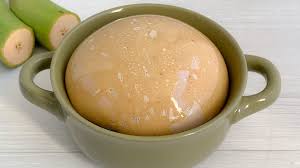
Difference between plantain fufu and yam fufu
Plantain fufu and yam fufu are both popular West African dishes that serve as a staple in many traditional meals. While they share similarities, there are distinct differences between the two. Here’s a comparison of plantain fufu and yam fufu:
- Ingredients:
- Plantain Fufu: Plantain fufu is primarily made from ripe plantains, which are starchy fruits with a sweet taste. The plantains are boiled and mashed to create a smooth, dough-like consistency.
- Yam Fufu: Yam fufu, on the other hand, is made from yam, a root vegetable. Yam has a neutral flavor and a starchy texture. The yam is boiled, pounded, and kneaded until it forms a soft, elastic dough.
- Flavor and Texture:
- Plantain Fufu: Plantain fufu has a slightly sweet flavor due to the natural sweetness of ripe plantains. It has a smoother and lighter texture compared to yam fufu, resembling mashed potatoes.
- Yam Fufu: Yam fufu has a more neutral taste, allowing it to absorb the flavors of the accompanying soups or stews. It has a denser and thicker texture, similar to dumplings or gnocchi.
- Nutritional Profile:
- Plantain Fufu: Plantain fufu is a good source of carbohydrates, dietary fiber, and essential vitamins and minerals such as vitamin C, vitamin A, potassium, and magnesium. It also contains resistant starch, which has benefits for digestive health.
- Yam Fufu: Yam fufu is rich in carbohydrates, dietary fiber, vitamin C, vitamin B6, potassium, and manganese. It provides a good amount of energy and offers various health benefits, including support for heart health and digestion.
- Culinary Uses:
- Plantain Fufu: Plantain fufu is often served with a variety of West African soups and stews, such as egusi soup, groundnut soup, or palm nut soup. It acts as a base and complements the flavors of the accompanying dishes.
- Yam Fufu: Yam fufu is commonly paired with soups like ogbono soup, banga soup, or vegetable soup. Its thick and hearty texture makes it an excellent choice for sopping up the flavorful sauces.
In summary, while both plantain fufu and yam fufu are delicious and nutritious, they differ in terms of ingredients, flavor, texture, and culinary applications. Each has its own unique qualities that contribute to the diverse and vibrant West African cuisine.
Video Credit: Best Pounded Yam recipe
How to Make Fufu from Scratch – Authentic Fufu Recipe
Conclusion:
Plantain fufu is a delightful culinary creation that brings a unique twist to the traditional African fufu recipe. With its simplicity and delicious flavors, it has become a popular choice for those seeking a gluten-free alternative or simply a new culinary adventure. By following the easy steps outlined in this recipe, you can enjoy a homemade plantain fufu that will impress your family and friends. So, why not give it a try and embark on a gastronomic journey through the flavors of Africa?
FAQs
What is plantain fufu?
Plantain fufu is a popular West African dish made from ripe plantains. The plantains are boiled and mashed to create a smooth, dough-like consistency, which serves as a base for soups and stews.
How is plantain fufu different from regular fufu?
Regular fufu is typically made from starchy ingredients like yam, cassava, or plantains. Plantain fufu, as the name suggests, specifically uses ripe plantains. It has a slightly sweet flavor and a smoother, lighter texture compared to other types of fufu.
Is plantain fufu gluten-free?
Yes, plantain fufu is naturally gluten-free since it does not contain any wheat or gluten-containing ingredients. It can be a suitable alternative for individuals with gluten intolerance or those following a gluten-free diet.
What soups or stews can I serve with plantain fufu?
Plantain fufu pairs well with a variety of West African soups and stews, such as egusi soup, groundnut soup, palm nut soup, or vegetable soup. It acts as a versatile base that complements the flavors of these dishes.
Are there any variations of plantain fufu?
Yes, there are variations of plantain fufu that incorporate additional ingredients or spices to enhance the flavor. Some recipes include a combination of plantains and yam or cassava for a different texture. You can also experiment with adding spices like garlic powder or onion powder for added taste.
How do I make plantain fufu?
To make plantain fufu, you peel and slice ripe plantains, boil them until tender, and then mash them into a smooth consistency. The mashed plantains are shaped into balls or other desired forms before serving.

